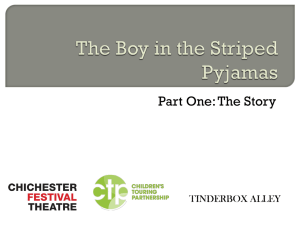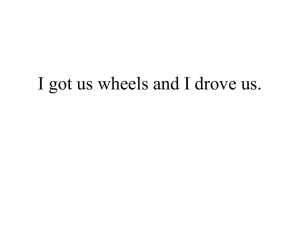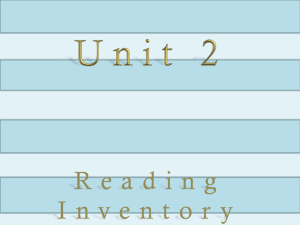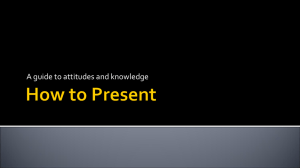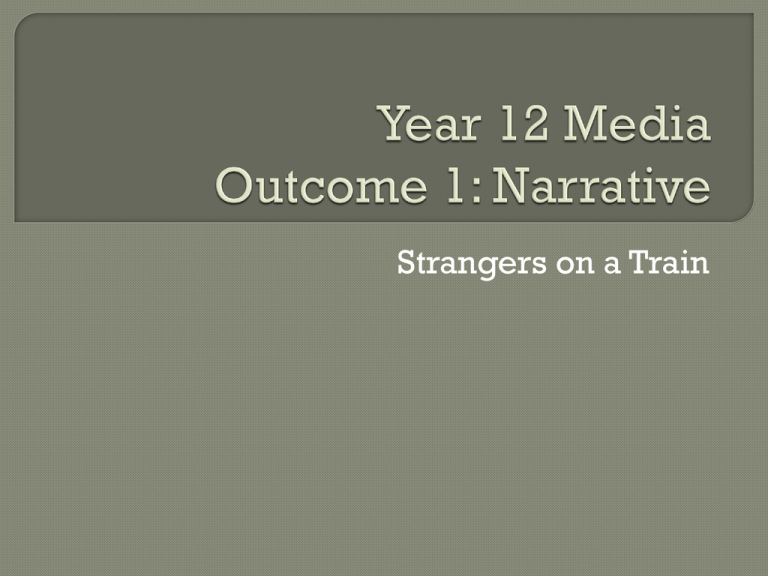
Strangers on a Train
NARRATIVE ELEMENTS
• Plot and story
• Structure
• Compression of time
• Opening and closing
• Characters
• Setting
• Themes, issues and motifs
• Point-of-view
• Cause and effect
Plot
and story
• Plot begins with Bruno and Guy arriving at the
station, ends with Anne and Guy on a train.
• Story includes elements such as the breakdown
of Guy and Miriam’s relationship, Guy meeting
Anne and her family, and Bruno becoming
estranged from his father.
Structure
• The plot is strictly linear, though other narrative
elements serve to keep things interesting.
Three-act structure
• Act 1: Ends with the murder of Miriam (Guy’s
“point of no return”)
• Act 2: Ends with Guy leaving Bruno’s house –
Bruno will “think of something”
• Act 3: Ends when the film ends (contains crisis
and climax).
Compression
of time
• A scene like the one between Guy and Bruno in
Bruno’s train compartment is quite lengthy and
plays out in more or less ‘real time’. There is little
compression of time there. This gives the
audience a stronger sense of ‘being there’,
experiencing the tension between the
characters at the same time they do.
• By contrast, the time from when Guy begins his
tennis match at Forest Hills to the aftermath of
the carousel crash is compressed considerably –
several hours are compressed down into roughly
twenty-five minutes.
• This compression of time is dictated by the
script, and demonstrated in the mise-en-scene,
such as the sun setting in the distance behind
Guy or the numerous clocks we are shown.
• It also comes through the editing, especially
when we see that the sun has set further behind
Guy than behind the fair at Metcalf.
Compression of time
• It also comes through the sound, especially
through the dialogue of the tennis commentator
and the umpire.
(“Game Mr Reynolds...Advantage Mr
Reynolds...Game Mr Reynolds.”)
Opening
• Opening does many things:
Credits establish mood and location.
Sets up characters of Guy and Bruno through
costumes (flamboyant sports shoes for gregarious
Bruno, sensible work shoes for conservative Guy)
Sets up idea of the ‘double’ - editing and camera
movement convey that they’re different but somehow
connected, heading unstoppably towards each other.
Railway tracks serve as a symbol of paths colliding
(as Bruno calls it “criss-cross”).
Closing
• Closing is abrupt, but has the effect of a
punchline, thereby relieving tension and
drawing attention to the director; it’s like
Hitchcock is giving the audience a wink.
• In this way it serves as a model of the
‘pleasure/pain’ dichotomy – Hitchcock knows we
go to the movies to be both scared and
delighted.
Closing
• A priest asks Guy what Bruno originally asked
him, but Guy’s character has developed so he
knows better than he did at the start.
• Character resolution: it seems important that we
see Guy with Anne. He has gotten the girl and,
therefore, the political career (and the secure
masculinity).
Characters
• Guy Haines (Farley
Granger)
Established as the
protagonist: clean-cut,
moral, handsome,
conservative, has physical
prowess (tennis) but
ambitious – wants to be a
politician. “I may be oldfashioned but I thought
murder was against the
law.”
Develops as he is
presented with
challenges, mainly by the
antagonist, Bruno.
Becomes more of a risktaker (as the tennis
commentator suggests, he
moves away from his
usual “watch-and-wait”
strategy).
Relationship with Bruno is
central to the film. Bruno
can be seen as
representing Guy’s
“shadow” (his ‘dark side’
– the things he doesn’t
want to admit about
himself).
Relationship with Anne is
important, particularly for
how under-developed it
is.
Guy’s overarching
motivation seems to be
his desire to break into
politics. Whether this is a
result of the survival
instinct or male
competitiveness is a
matter of opinion. This
also helps to explain his
rather bloodless
relationship with Anne.
Mervyn Nicholson says:
“There is no indication of
any political agenda or
cause that means anything
to this young man. [He is]
someone who wants to
climb the ladder of power
and prestige...perhaps
fuelled by strong feelings
of social inferiority
(symbolised by Miriam)
and of threatened identity
due to failed ambition.”
Characters
• Bruno Antony (Robert
Walker)
Established as the
antagonist: suave and
smooth but effeminate
and, therefore,
threatening to Guy.
Established as a loser or a
‘bum’ in comparison to
Guy: “I certainly admire
people who do things.”
• Minimal development
across the course of the
narrative. His strengths
and weaknesses at the
end are the same as at
the start.
• The only thing that
really changes is how
much information the
audience has about him.
His guilt over Miriam’s
murder (to the point of
collapsing at the party)
is the first real sign of
his weakness, but we
can assume this is an
innate aspect of his
character.
• His relationship with Guy
is key.
• His close relationship with
his mother is significant,
and is used to suggest his
homosexuality or, at least,
his ‘difference’. There is
an Oedipal quality to their
relationship; that is, she
seems closer to Bruno
than she does to her
husband.
• His relationship with his
father hints at his
estrangement (or “long
distance”) from the
patriarchal American
society. The bemused
response of Anne’s
father, Senator Morton,
when he meets Bruno,
helps to reinforce how
distant Bruno is from the
‘norm’.
• His motivation echoes
that of Guy’s. He wants
to be accepted by
society, and thinks he
can achieve this if he
can merge his persona
with Guy’s...to, in a
sense, ‘become’ Guy.
• Unfortunately for him, he
just isn’t up to it because
he’s a psychopath. His
methods of getting what
he wants are not morally
or socially acceptable,
whereas Guy’s are.
Playing tennis, getting into
politics and romancing a
refined lady are far more
acceptable ways of
“winning” than murder.
Setting
– physical/geographical
• United States, 1951.
• New York City: Forest Hills Tennis Club
• Metcalf: fictional town between NYC and
Washington DC. Guy and Miriam’s hometown.
• Washington DC: Political centre of USA. Guy
lives there now, as do the Mortons.
Setting
– physical/geographical
Setting
– physical/geographical
• New York City: represents success, “winning”.
• Metcalf: represents Guy’s old “loser” life,
connected closely to Miriam. The amusement
park is a place to kill time.
• Washington DC: represents Guy’s aspirations to
be involved in politics.
Setting
– physical/geographical
The Capitol Building
(House of Congress)
looms large over the
street outside Guy’s
house. Close
inspection reveals it’s
a composite image,
so it’s a very
deliberate choice on
Hitchcock’s part.
Setting
– physical/geographical
The Thomas
Jefferson Memorial.
Bruno stands
ominously on the
steps as Guy drives
past, an obstacle to
Guy’s political
ambitions.
Setting – social
• Wealthy, proper,
upper-class society in
Washington. Very white
(and note the black
manservants). At the
party are the d’Arvilles
(representative of
education and culture),
the judge (symbol of
mainstream morality)
and important military
men.
Setting – social
• Washington contrasts
with the simple, smalltown values of Metcalf. In
the scene at right, the
tree, a bold slash down
the middle of the screen
helps to emphasise the
divide between Bruno
and the amusement park
man, who says, “Okay, so
I ain’t educated.” And the
crates of cheap root beer
stand in stark contrast to
the martinis of the
Washington soiree.
Setting
– emotional/atmospheric
• Hitchcock “plays against type” with his settings,
especially at the amusement park.
• The amusement park is typically a place of
frivolity and fun, but because we know that Bruno
is intent on killing Miriam, the atmosphere
becomes much more sinister. Setting it there
makes it perhaps even more frightening than if it
were in a dark alley, or a seedy bar. This is
emphasised by the insistent organ-grinder style
music arranged and selected by Dimitri Tiomkin,
and the high-contrast tonality of the images.
• It’s also symbolic of Guy’s psyche. It is in Metcalf,
his home town, which connects it to his youth and
the formation of his character.
• The fact that Bruno ventures into not only Guy’s
hometown (his psyche) but into the part of it
devoted to freedom, liberation and pleasure,
passing through the “tunnel of love” on the way,
to kill off the thing holding Guy back from being
free and happy (Miriam), makes it even more
symbolic.
Consider the significance of the lyrics to “The
Band Played On”:
Casey would waltz with a strawberry blonde
And the band played on;
He'd glide 'cross the floor with the girl he adored
And the band played on;
But his brain was so loaded it nearly exploded
The poor girl would shake with alarm;
He'd ne'er leave the girl with the strawberry curls
And the band played on.
Themes
• Innocence and guilt
Is Guy guilty because he wished
Miriam were dead?
Guilt is the one thing that
weakens Bruno, but it only shows
itself under certain
circumstances (i.e. when he sees
Babs). What is it about Babs that
draws out Bruno’s guilt? Is it just
the resemblance to Miriam?
The line between guilt and
innocence is very fine.
Themes
• Fate vs. self-determination
We can never completely control our fate. Guy and
Bruno are on the “tracks” of their lives and there is no
getting off them – just as there is no getting off the
carousel.
Both characters seek to control their fate but only
Guy gets what he wants. Why does fate smile upon
him?
Issues
Social class
Guy is looking to move up a social class from his lowermiddle upbringing in Metcalf, of which Miriam is symbolic.
He realises he’ll need to work hard to do this but also,
arguably, takes advantage of his connection with Anne for
social progression.
Issues
Social class
Bruno is born into wealth but is ambivalent towards it. He
seems to have no desire to leave home, nor is he willing to
work for his father. Though his mother says he gets up to
“all sorts of escapades”, he seems to contribute nothing to
society. Still, he clings on to his social airs and graces when
he realises they can pull him up into Guy’s milieu (such as
at the tennis or at Babs’ party). He also prides himself on his
‘education’: “I’m sure I don’t know what a smoocher is.”
Issues
Sexual repression
Many critics have viewed the
film as an exploration of sexual
psychology, arguing that Guy is
gay and that Bruno is simply a
representation of Guy’s
homosexual desires (which lurk
forever in the ‘shadows’).
Issues
Sexual repression
This is simply an interpretation,
as explicit references to any
character’s homosexuality are
absent. But there is a good deal
of evidence to support it.
For a start, sexuality was a
typical issue for Hitchcock’s
characters to grapple with.
Homosexuality figured most
notably in Rope (1948), which
stars Farley Granger (Guy!) and
John Dall as a pair of murderous
gay lovers.
Issues
Sexual repression
Bruno is depicted as
homosexual. His smooth, slightly
effeminate way of speaking; his
close relationship/identification
with his mother; his distance
from his patriarchal father; his
fastidiousness about his nails;
his flamboyant shoes: all of
these elements would have
been recognisable (albeit
stereotypical) gay
characteristics to audiences at
the time.
Issues
Sexual repression
Whether or not this means Guy
is also gay is a matter of opinion,
but it does help to explain a lot
of things: his desperation to fit in
to society; his unconvincing
relationship with Anne; his
rejection of Bruno; the lustful
quality of his grappling with
Bruno on the carousel...and the
Freudian notion of the repressed
sex drive is explored in so many
of Hitchcock’s film.
Issues
Sexual repression
To figure out what Hitchcock is
suggesting about homosexuality
is difficult. The ‘gay guy’ is clearly
also the ‘bad guy’ (thereby
equating ‘gay’ with ‘bad’), but we
are so often invited to empathise
with him and enjoy his antics. He
is certainly more fun than Guy or
Anne.
Perhaps the film is a depiction of
how difficult it was to be gay (or
sexually aberrant in any way) at
the time...
Motifs
The double
Truffaut said to Hitchcock, “This picture is systematically
built around the figure ‘two’...Whether it’s Guy or Bruno, it’s
obviously a single personality split in two.” Hitchcock
agreed, saying: “That’s right. Though Bruno has killed Guy’s
wife, for Guy it’s just as if he had committed the murder
himself.”
Motifs
The double
Consider all the doubles in the film:
Guy and Bruno
Miriam and Barbara (girls with glasses)
Two taxis
Two pairs of feet
Two suitcases
Two tennis rackets
Two train tracks
Double scotches, a pair
Two boys with Miriam
Hitchcock carrying a double bass as a double of himself
Mrs Cunningham and Mrs Anderson
Captain Turley and Sergeant Campbell
Hennessey and Hammond...(the list goes on).
Motifs
The double
Freud's first thesis:
The uncanny (of which ‘the double’ is an example) arises due
to the return of repressed infantile material. It can represent
firstly, everything that is unacceptable to the ego, all
its negative traits that have been suppressed, or it can embody
all those utopian dreams, wishes, hopes that are suppressed
by reality.
Motifs
The double
This has particularly interesting implications for Guy and
Bruno. Bruno could represent everything that Guy has
repressed about himself (whether it’s homosexuality or his
primitive, socially unacceptable urges in general – think “I
could strangle her!”), while Guy represents to Bruno
everything that he wants to be – the perfect man, accepted
into the utopian lifestyle of Washington politics. In this way,
they complement each other perfectly.
Other
motifs
Hands, especially Bruno’s
Other
motifs
Eyes and seeing
Other
motifs
Light and shadow
Other
motifs
“Criss-cross”
Point-of-view
• Story-wise, the audience’s point-of-view is
generally omniscient, but we are invited to
empathise in quite equal measure with Guy
and Bruno.
• There are only a few scenes that don’t relate to
their perspectives, such as: Babs telling Anne
about Bruno’s “trance”; Babs sweet-talking
Hennessey; Hennessey and Hammond talking;
and the shots of the train tracks.
Point-of-view
• There are many moments where the camera
work is subjective, or very close to it...
Cause
and effect
• Important examples of cause and effect:
Bruno and Guy bump feet on the train
Bruno
looks at Guy and recognises him
Bruno kills Miriam
Guy must prove his
innocence
Bruno sees Babs at the party
Bruno faints
The detective shoots the carousel operator
The
carousel spins out of control
• Remember, though, that cause and effect
includes both plot and story.
PRODUCTION
ELEMENTS
• Cinematography
• Mise-en-scene
• Editing
• Sound
Cinematography
• Framing (“Dutch angles”)
Cinematography
• Angles (high and low)
Cinematography
• Focus (deep and shallow)
Cinematography
• Camera movement
Cinematography
• Film stock (35mm black and white)
Mise-en-scene
• Production design
Set design
Set decoration
Props
Mise-en-scene
• Costume design
Mise-en-scene
• Lighting
Mise-en-scene
• Figure expression and movement (acting)
Mise-en-scene
• Figure expression and movement (acting)
Mise-en-scene
• Figure expression and movement (acting)
Mise-en-scene
• Figure expression and movement (acting)
Editing
• Transitions (cross-dissolve or cross-fade)
Editing
• Transitions (cross-dissolve or cross-fade)
Editing
• Parallel editing
Editing
• Shot/reverse-shot
Editing
• Shot/reverse-shot
Sound
• Music
Sound
• Music
Sound
• Music
Sound
• Music
and
sound
mix
Sound
• Off-
screen
sound
Sound
• Sound
effects



